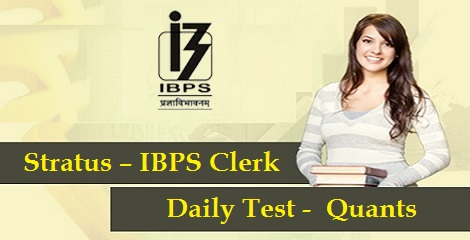Hello Aspirants,
Welcome to Online Quant Section in AffairsCloud.com. We are starting IBPS Clerk course 2015 and we are creating sample questions in Quantitative Aptitude section, type of which will be asked in IBPS Clerk Main Exam.
Stratus – IBPS Clerk Course 2015

[flipclock]
- The average monthly income of four members of a family is Rs 15,625. One of the daughters got married and went. Now the average monthly income of the family is Rs 15,559. Find the monthly income of the daughter who got married.
A) Rs 15,625
B) Rs 16,823
C) Rs 15,823
D) Rs 15,328
E) None of theseC) Rs 15,823
Explanation:
After daughter got married, 3 members left in family. So
Ans = (4*15625) – (3*15559) - A bag contains 3 blue balls, 5 yellow balls and 4 green balls. 2 balls are drawn at random. What is the probability that either both balls are yellow or green in color?
A) 10/11
B) 2/11
C) 8/33
D) 19/22
E) None of theseC) 8/33
Explanation:
From 5 yellow balls, ways for 2 ball is 5C2 = 5*4/2*1 = 10
From 4 green balls, ways for 2 ball is 4C2 = 4*3/2*1 = 6
There are a total of 12 balls. Ways for drawing 2 balls is 12C2 = 12*11/2*1 = 66
So required prob. = (10+6)/66 = 8/33 - A man starts from a point P at 7 AM and reaches another point Q at 12 Noon. Another man starts from point Q at 8 AM and goes in opposite direction to the first man and reaches point P at 2:30 PM. Find the approximate time at which they will both meet.
A) 10:16 AM
B) 10:30 AM
C) 11:00 AM
D) 09:48 AM
E) None of theseA) 10:16 AM
Explanation:
We have a direct formula for finding this:
7 AM + [(12 Noon – 7AM) * (2:30 PM – 7 AM) / (12 Noon – 7AM)+(2:30 PM– 8AM)]
7AM + [ (5 * 7 1/2 )/(5 + 6 1/2)]
7AM + 75/23
7AM + 3 6/23
10 AM + (6/23) * 60
≈ 10:16 AM
OR
Let distance between P and Q is d
now 1st man starts from at 7 am and reaches at 12 noon i.e. takes 5 hrs, so speed of this man = d/5
2nd man from Q to P takes 6 n half hrs, so speed of 2nd man is 2d/13
1st man, after 1 hr i.e. at 8 AM has traveled (d/5) km.
so at 8 AM 2nd man also starts and now the distance between 1st and 2nd man is (d – d/5) = 4d/5
so they will meet at
8 AM + (4d/5)/[(d/5) + (2d/13)] [in denominator, relative speed of both men]
= 8 AM + 2 (6/23)
= 10 AM + (6/23) * 60
≈ 10:16 AM - Meena invested a certain amount at the rate of 5% per annum for 4 years and obtained a simple interest of Rs 312. Had she invested the same amount at 4% per annum compounded annually, what would be the compound interest obtained after 2 years.
A) Rs 200
B) Rs 127
C) Rs 260
D) Rs 156
E) Rs 256B) Rs 127
Explanation:
312 = P*5*4/100
So principal = Rs 1560
CI = 1560 [(1 +4/100)^2 – 1]
= 1560 [676/625 – 1] - A solution of milk and water contains 60% of water by weight. If in 500 gms of solution, 100 gm of water is added, what is the percentage of water in the new solution?
A) 66 2/3%
B) 62%
C) 70 1/5%
D) 65%
E) None of theseA) 66 2/3%
Explanation:
In 500 gm, water is 60/100 * 500 = 300 gm
Now 100 gm of water added, so water become (300+100) = 400gm
Total solution becomes (500+100) = 600 gm
Required % = (400/600) * 100 - The perimeters of the bases of two right circular cones is 3 : 4. If the ratio of their heights is 1 : 2 respectively, find the ratio of their volumes.
A) 9 : 32
B) 3 : 32
C) 9 : 29
D) 6 : 31
E) None of theseA) 9 : 32
Explanation:
2ᴨr1 : 2ᴨr2 = 3 : 4
So r1/r2 = 3/4
h1/h2 = 1 : 2
ratio of volumes = 1/3 ᴨ r12h1 : 1/3 ᴨ r22h2
= (3/4) 2 * 1/2 = 9/32 - A, B and C invested Rs 5000, Rs 6000 and Rs 6500 in a business at the start of a year. After 4 months all of them withdraw Rs 500. After a total of 8 months from the start of business all invest Rs 500 more. Find the ratio in which the total profit will be shared among them at the end of a year.
A) 28 : 34 : 37
B) 29 : 35 : 38
C) 34 : 28 : 37
D) 16 : 25 : 34
E) None of theseB) 29 : 35 : 38
Explanation:
After 4 months all withdraw Rs 500 and after another 4 months (8 months from start) all add Rs 500. So this means 5000, 6000 and 6500 are invested for 4+4 = 8 months and with Rs 500 withdraw 4500, 5500 and 6000 are invested for 4 months respectively by A, B and C.
So ratio =
5000*8 + 4500*4 : 6000*8 + 5500*4 : 6500*8 + 6000*4
U are not required to calculate all the values, rather u can cancel out common terms
50*2 + 45 : 60*2 + 55 : 65*2 + 60 [I have taken 400 common from all]
Again take 5 common from all, this gives
10*2 + 9 : 12*2 + 11 : 13*2 + 12
29 : 35 : 38 - Asha and Rekha together can complete a work in 12 days. Asha alone can complete that work in 20 days. Find the number of days in which both will complete the work if Rekha works for only half a day daily.
A) 15 days
B) 25 days
C) 10 days
D) 30 days
E) None of theseA) 15 days
Explanation:
Rekha’s 1 day’s work = 1/12 – 1/20 = 1/30
Now in 1day Rekha completes 1/30 of the work, so in half day she will complete 1/2 * 1/30 = 1/60 of the work
Now Asha’s 1 day’s work is 1/20 and Rekha’s 1/60
So their total 1 day’s work = 1/20 + 1/60 = 1/15 - Sumedha gets successive discounts of 20% and 5% and buys an article marked at Rs 25,000. She spends Rs 1,000 on its repairs and sells the same for Rs 25,000. Find her profit percent.
A) 30%
B) 26%
C) 20%
D) 25%
E) None of theseD) 25%
Explanation:
Successive discounts of 20% and 5% makes overall discount of (-20) + (-5) + (-20)(-5)/100 = -25 +1 = -24%
So she buys the article for [(100-24)/100] * 25000 = 19,000
Spends 1000 on repairs, so total CP = 1000 + 19000 = 20,000
SP = 25,000
So profit% = (5000/20000) * 100 - In an examination it is required to get 297 marks of the aggregate marks to pass. A student gets 29% marks and is failed by 36 marks. Fins the maximum aggregate marks a student can get.
A) 650
B) 900
C) 800
D) 850
E) None of theseB) 900
Explanation:
He got failed by 36 marks so has received (297-36) = 261 marks which is equal to 29% of aggregate marks
So 29% of aggregate marks = 261
aggregate marks = 26100/29 = 900
AffairsCloud Recommends Oliveboard Mock Test
AffairsCloud Ebook - Support Us to Grow
Govt Jobs by Category
Bank Jobs Notification



